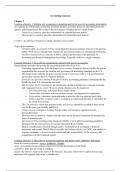Samenvatting
Samenvatting Horngren's Accounting, Global Edition - Accounting (MAN-BCU168)
- Instelling
- Radboud Universiteit Nijmegen (RU)
Samenvatting van het boek voor het vak Accounting op de Radboud Universiteit. Bedrijfskunde jaar 1. Het vak is MAN-BCU168. Samenvatting in het Engels. Begrippen en onderzoekers schuingedrukt. Samenvatting van het boek Nobles, Mattison, Matsumura – Horngren’s accounting, 10th edition, ISBN 6517....
[Meer zien]





